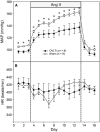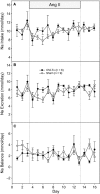OVLT lesion decreases basal arterial pressure and the chronic hypertensive response to AngII in rats on a high-salt diet
- PMID: 24303192
- PMCID: PMC3841056
- DOI: 10.1002/phy2.128
OVLT lesion decreases basal arterial pressure and the chronic hypertensive response to AngII in rats on a high-salt diet
Abstract
We have reported that lesion of the organum vasculosum of the lamina terminalis (OVLT) has no effect on basal levels of mean arterial pressure (MAP) but abolishes the hypertensive effects of angiotensin II (AngII) in rats consuming a normal-salt diet. These results suggest that the OVLT does not contribute to regulation of MAP under conditions of normal salt intake, but it is an important brain site for the hypertensive actions of AngII. The OVLT has been proposed as a major sodium sensor in the brain and the hypertensive effects of AngII are exacerbated by high-salt intake. Therefore, the objective of this study was to investigate the role of the OVLT during AngII-induced hypertension in rats fed a high-salt diet. Male Sprague-Dawley rats underwent sham (Sham; n = 9) or OVLT lesion (OVLTx; n = 8) surgery and were placed on a high-salt (2% NaCl) diet. MAP was measured by radio telemetry during three control days, 10 days of AngII infusion (10 ng/kg/min, i.v.), and a 3-day recovery period. MAP was significantly lower in OVLTx (97 ± 2 mmHg) compared to Sham (106 ± 1 mmHg) rats during the control period (P < 0.05). Moreover, the chronic pressor response to AngII was markedly attenuated in OVLTx rats. MAP increased 58 ± 3 mmHg in Sham rats by Day 10 of AngII compared to a 40 ± 7 mmHg increase in OVLTx rats (P < 0.05). We conclude that (1) the OVLT regulates the basal levels of MAP in rats consuming a high-salt and (2) the OVLT is an important brain site of action for the pathogenesis of AngII-salt hypertension in the rat. Supported by HL076312.
Keywords: Angtiotensin II; OVLT; circumventricular organ; hypertension.
Figures





References
-
- Allen AM, Zhuo J, Mendelsohn FOA. Localization and function of angiotensin AT1 receptors. Am. J. Hypertens. 2000;13:39S–44S. - PubMed
-
- Anderson JW, Washburn DLS, Ferguson AV. Intrinsic osmosensitivity of subfornical organ neurons. Neuroscience. 2000;100:539–547. - PubMed
-
- Bains JS, Ferguson AV. Paraventricular nucleus neurons projecting to the spinal cord receive excitatory input from the subfornical organ. Am. J. Physiol. 1995;268:R625–R633. - PubMed
-
- Brody MJ, Fink GD, Buggy J, Haywood JR, Gordon FJ, Johnson AK. The role of the anteroventral third ventricle (AV3V) region in experimental hypertension. Circ. Res. 1978;43:1–13. - PubMed
Grants and funding
LinkOut - more resources
Full Text Sources
Other Literature Sources

